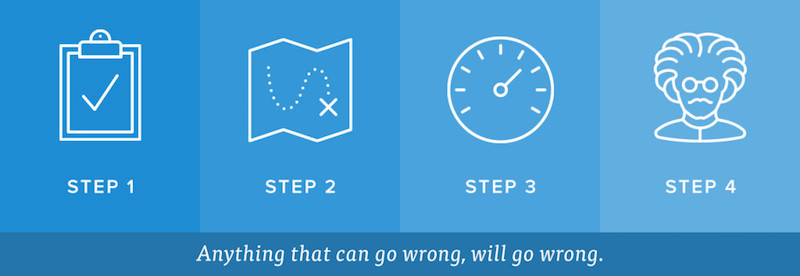How to use the techniques of rationality to soundproof decisions
Every time you’re faced with a decision, your brain immediately starts trying to connect the dots, and jump to conclusions. You may know you want to finish some tedious work (like your taxes). You probably even know you’ll later regret procrastinating. And yet, you still put it off. Why?
Our brains are made up of many distinct parts that don’t always work well together. By understanding how your brain works, you can make better decisions around everything from what you should get for lunch to how much you can spend on a house. In Berkeley, California, the Center for Applied Rationality aims to use math and science to develop and teach techniques that anyone can use to more effectively solve the most important problems in their lives.
What is rationality?
At the very basic level, rationality is the act of creating an accurate model of the world to help us achieve our goals. This process involves overcoming bias and changing habits. Cognitive scientists have discovered two systems of thinking that help us make decisions: system 1, which tackles fast, effortless, and automatic processes in our brain (such as ducking when a ball comes flying at your head) and system 2, which includes the processes that allow abstract thinking (such as math and logic).
Both systems are indispensable and you can play to each one’s strengths. Integrate their inputs in order to become a better decision maker, to recognize what you want and value, and then go after it with a passion, all the while avoiding the predictable errors that we all tend to make.
Your inner simulator and other ‘advisors’
In order to become a better decision maker, you need learn to work with your inner ‘advisers, some of whom might steer you in the wrong direction, get sidetracked by wishful thinking, or stick too close to comfort to take on a new situation. In the work environment, you’ll want to learn how to avoid giving answers that are socially convenient, as opposed to correct.
The primary players in this circle are your inner simulator and verbal/explicit models, though many others exist as well. Your inner simulator, much like a joint or muscle, reacts to events based on experience and example, while your explicit/verbal models are the parts of your brain that can better reason novel situations, and able to take in new knowledge and put it into action.
Think of the former as helping you catch a ball, while the latter informs how you solve a puzzle or come up with a plan for the future. Both systems are going to make mistakes in different and predictable situations, and our goal is to query them at different times, avoid their predictable weaknesses, and come up with a set of strategies that will help us differentiate between the good advice, and the bad.
How to effectively interview your inner simulator and ‘talk’ to verbal models
Your inner simulator has been trained to react to situations based on years of experience; its power is to help you make a decision, fast. But it, too, can be mistaken; while in a more calm state you might know that you should never hit the brakes while driving on ice, when your tires start to skid, your first reaction might very well be to hit those breaks.
Meanwhile, there’s your explicit/verbal model: it’s able to acknowledge and react to novel situations, but it’s vulnerable to distortion by wishful thinking and ideology (remember the big project metaphor from earlier?).
Updating your inner simulator’s verbal model requires practice, and once you refine this process, you’ll find that your judgement will be more attuned to reality, and you’ll be better able to handle stressful situations. One way to fine-tune your reactions is to call on your Surprise-o-meter: a simple test aimed at testing your systems to begin establishing a plan B.
Murphyjitsu: Techniques for becoming a decision-making pro
Practice makes perfect, and it couldn’t be more true when it comes to thinking. Next time you’re faced with a big (or small) decision, try the following approach: Murphyjitsu
You’re probably familiar with Murphy’s Law — the ‘rule’ that anything that can go wrong, will. The best way to make a smart decision is to Murphy-proof our plans: to consider all the possibilities, and come up with an action plan.
4 steps to Murphy-proof your next big decision:

- Pick a plan, project, or goal. Imagine it has already happened or been completed.
- Decide what is the next action you need to take in order to move forward on this plan.
- Call on your Surprise-o-meter. Imagine the wildest outcomes of your plan. Are you shocked by it? If yes, stop here — you’re prepared for the worst. Not shocked? Move on to the next step.
- Call in pre-hindsight: what causes or explanations leap to mind when you’re trying to understand ‘what went wrong?’ Sometimes, you’ll find you’re actually able to articulate the problems and foresee them, before you ever start actioning on your plan.
At the end of this exercise, you should have a list of system 1 plausible failure modes, i.e. what might happen if things go awry. Now, you’re better equipped to make contingency plans. Map out if a specific situation you envisioned arose, what specific action would you take? Unsatisfied with your plausible failure modes? Iterate! Go back to the Surprise-o-Meter and walk through the possible outcomes again.
If you make a habit of using this process for major decisions a couple of times per week, you’ll find yourself passively tapping into your inner simulator to flag ‘alerts’ that need attention.
For further reading…
More Issues
